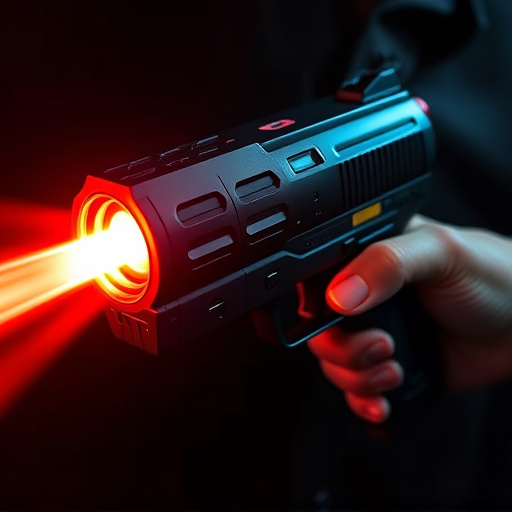The Master Blaster stun gun temporarily disables targets through neuromuscular disruption caused by high-voltage, low-current electrical pulses. Its effectiveness varies based on power output, targeted area, individual health, tolerance levels, and skin condition, lasting 2 to 15 minutes on average. Despite its compact design and safety features, legal restrictions and proper training are crucial for responsible use to avoid injuries and legal issues.
“Uncovering the impact of stun guns, particularly the Master Blaster model, on human muscles is crucial for understanding their effectiveness and potential risks. This article delves into the science behind muscle incapacitation caused by stun devices, focusing on the popular Master Blaster stun gun. We explore what happens to the body during deployment, its unique features, and the duration of muscle disruption it causes. Additionally, legal aspects and safety precautions surrounding stun guns are discussed, providing a comprehensive guide for informed use.”
- Understanding Muscle Incapitation: What Happens When Stun Guns Are Used?
- The Master Blaster Stun Gun: Features and Effects on the Body
- Duration of Disability: How Long Does Muscle Incapitation Last?
- Legal Considerations and Safety Precautions with Stun Guns
Understanding Muscle Incapitation: What Happens When Stun Guns Are Used?
When a master blaster stun gun is deployed, its primary effect is to temporarily incapacitate the target by disrupting their neuromuscular transmission. This results in muscle spasms and loss of control over bodily movements. The duration of this muscle incapacitation varies based on several factors, including the stun gun’s power output, the area targeted, and the individual’s overall health and tolerance levels.
Stun guns emit high-voltage, low-current electrical pulses that interfere with nerve signals to muscles. This interference triggers an intense but brief response from the body, leading to muscle contractions and a sense of numbness or paralysis. Typically, the effects last for several seconds, during which time the targeted individual becomes temporarily immobilized. However, it’s crucial to note that resistance can vary greatly among individuals, and factors like wet or sweaty skin can also impact the stun gun’s effectiveness and duration of incapacitation.
The Master Blaster Stun Gun: Features and Effects on the Body
The Master Blaster Stun Gun is a powerful tool designed for self-defense, utilizing high voltage and low amperage to incapacitate targets temporarily. Its primary effect on the body is through neuromuscular disruption, leading to muscle spasm, loss of balance, and coordination. The stun gun fires electrical charges that interfere with the nervous system’s signals to muscles, causing them to contract uncontrollably. This results in a significant reduction in physical abilities, enabling the user to gain control or escape from dangerous situations.
This device is known for its rapid deployment and high effectiveness, making it a popular choice among law enforcement and civilians alike. The Master Blaster Stun Gun typically renders a target unconscious for several minutes, providing crucial time for users to evacuate or subdue a potential threat. Its compact design, combined with the short but intense pulse of electricity, ensures that even in close-quarters combat, the stun gun can be wielded effectively to disable an attacker without causing permanent harm.
Duration of Disability: How Long Does Muscle Incapitation Last?
The duration of muscle incapacitation from a stun gun, like the Master Blaster stun gun, varies depending on several factors. Studies suggest that the effects can last anywhere from 2 to 15 minutes, with an average disability period of around 5-7 minutes. This time frame is based on the stun gun’s electrical current strength and the target’s physical attributes, including muscle mass and overall fitness level.
A key factor in determining duration is the stun gun’s output voltage. Higher voltage can lead to longer periods of incapacitation. The Master Blaster, for instance, often delivers a powerful jolt with a high voltage, potentially resulting in extended muscle paralysis compared to lower-voltage devices. Additionally, the target’s body size and resistance can influence how long the effects persist. Larger individuals may experience shorter durations due to their higher overall resistance to electrical current.
Legal Considerations and Safety Precautions with Stun Guns
When it comes to the use of stun guns, such as the popular Master Blaster stun gun, there are significant legal considerations and safety precautions to bear in mind. The duration of muscle incapacitation caused by a stun gun is a key factor in its effectiveness and legality. Different jurisdictions have varying laws regarding the use of stun guns, with some requiring permits or restricting their use to law enforcement only. Understanding these legal frameworks is essential before considering the purchase and deployment of such devices.
Safety precautions are equally vital. Stun guns deliver an electric shock that can temporarily paralyze a target, but they come with risks. Users must be trained appropriately to ensure safe handling, as incorrect usage could lead to severe injuries or even death. It’s crucial to follow manufacturer guidelines, store stun guns securely, and familiarize yourself with local laws to avoid legal repercussions and guarantee the safety of both the user and any individuals in proximity.
The Master Blaster stun gun, with its potent features, effectively disrupts muscle function through electric impulses. Research indicates that muscle incapacitation from such devices typically lasts for a duration ranging from 3 to 5 minutes. However, it’s crucial to consider the legal implications and safety precautions when using stun guns, as their effects can vary based on factors like distance, body size, and individual resistance. Understanding these aspects is vital for responsible usage and ensuring public safety in various scenarios.
